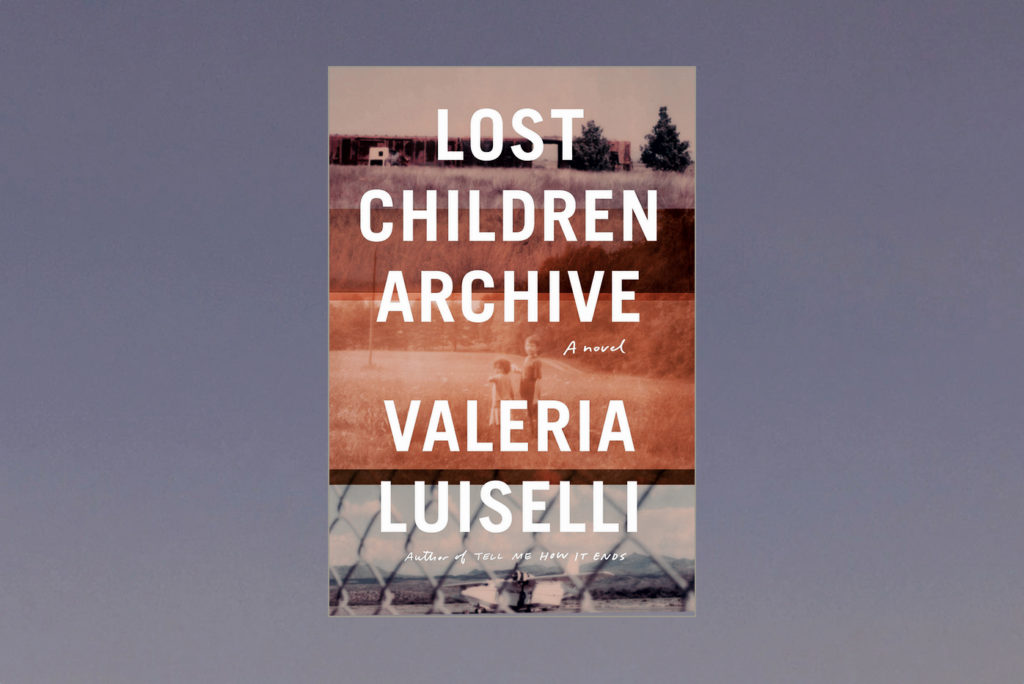An Inventory of Erasure: Limbo and Lucidity in “Lost Children Archive”

What are novels for? Some formulation of this question is bound to occur to readers of Valeria Luiselli when they encounter her latest novel, Lost Children Archive (Knopf, 2019), particularly as the central subject, a number of scenes, and some implicit and explicit arguments in this text have already been featured in her previous book, Tell Me How It Ends: An Essay in Forty Questions (Coffee House Press, 2017). In retrospect, Tell Me How It Ends feels like prologue and groundwork for the novel that came next, which in turn provides an insight into how an exceptional, impressive writer approaches the same subject from the contradistinctive vectors of fiction and facticity.
* * *
First, facticity: In 2014, while waiting for their green cards to be processed, Luiselli, her husband, and their two children participated in the most American of pastimes: they took a road trip, driving from New York City to the American Southwest. En route, their car radio began to relate the news of large waves of unaccompanied Central American minors crossing the U.S.-Mexico border at places like Nogales and Reynosa. Contrary to popular assumptions, the objective of these minors was not to sneak into the country, to live and work in the shadows as undocumented immigrants, but to surrender themselves to United States Customs and Border Protection in a bid to gain asylum and eventually legal residence.
In Tell Me How It Ends Luiselli writes that between April 2014 and August 2015, over 102,000 minors were detained, most after fleeing the economically integrated Northern Triangle—Guatemala, Honduras, and El Salvador—and making the long and perilous journey through Mexico. Central American migrants travel at great financial cost and enormous personal risk, escorted by coyotes, walking hundreds of miles and riding atop La Bestia (“the beast”), a collective term for the freight trains that run between the southern states of Mexico and the northern border regions. On the way to the United States these children are frequently injured, sexually assaulted, and robbed of what little they carry. Many are killed in accidents or through acts of violence. A not-small number die from exposure and exhaustion. Between 2006 and 2015, approximately 120,000 migrants simply disappeared.
The best-case scenario for the child migrant is to be arrested immediately after crossing the border, then descend into the Kafkaesque bureaucracy of immigration court, where a small fraction are allowed to remain in the United States if they can rapidly secure legal representation and adduce evidence of victimization, either by agents of law enforcement (in their home country or the U.S.) or the violent drug cartels that have arisen in the Northern Triangle as de facto parastates. The narrative of the essay Tell Me How It Ends accelerates after Luiselli and her family return to New York, where she volunteers as a translator at an immigration court and learns one of the cruelest ironies of this legal predicament: it is not the children who have endured the greatest suffering who are most likely to be allowed to remain in the country, nor those most likely to be killed or exploited if sent back. Rather, the children given asylum are those who can present official documentation or some other concrete evidence from a specific list of atrocities and abuses. “When children don’t have enough battle wounds to show,” Luiselli writes, “they may not have any way to successfully defend their cases and will most likely be ‘removed’ back to their home country, often without a trial.” Here, the epithet “undocumented” swells, taking on a meaning even more literal and pernicious.
* * *
Born in Mexico City in 1983, Valeria Luiselli is a multinational, multilingual writer who has risen to literary celebrity in less than a decade. Readers of her five published books do not wonder why. Luiselli is gigantically intelligent, yet direct and accessible. Her prose is impeccable and tends to deconstruct and agitate every object that falls into its gravitational field. Luiselli’s voice is intellectual, urbane, and allusive, however she writes from a point of view that is assiduously marshaled by her own humanity and moral focus, with a Teflon-coated frankness that prevents any accretion of what one might call elitism. In Tell Me How It Ends, she describes herself as a “chilanga.”
Luiselli’s second, breakout novel in English, The Story of My Teeth (Coffee House Press, 2015), is a work of fabulism less in the stream of her fellow émigré and Mexiqueño Gabriel García Márquez than her contemporaries Kelly Link and Karen Russell. Luiselli is also omnivorous and egalitarian—she quotes Gottlob Frege as naturally as Kendrick Lamar; she derived The Story of My Teeth from chapbooks written in a workshop-like collaboration with shift workers at the Jumex juice factory in the “marginalized, wasteland-like neighborhood of Ecatepec.” Luiselli’s humanity and equalitarianism are what entitle her to be a voice in hemispheric conversations about place, space, and identity, and what helps qualify her to write a book like Lost Children Archive. Her prose penetrates and interrelates nominally disconnected spaces, not as a kind of bridge so much as a burrowing eye that perceives and reveals subterranean conjunctions. Such is the case in her chthonic, katabatic first novel, Los ingrávidos (Sexto Piso, 2011), translated by Christina MacSweeney as Faces in the Crowd (Coffee House Press, 2014). This unexpected debut is a braid of supernatural allegories that resurrect and enlist minor poets and heavyweights alike (Ezra Pound, Louis Zukofsky, Gilberto Owen, Federico García Lorca) to help give ballast to a young Mexican translator living in New York City, who has begun to feel as weightless and ephemeral as the ghosts she sees on the subway. Faces in the Crowd is a book filled with passages you cannot help but underline and revisit. It is the kind of book you give away, then buy again so you can repeat the process, annotating and transferring, as if Luiselli’s recursivity has become infectious.
* * *
In Lost Children Archive, Luiselli’s narrator is the mother and wife of a blended family already beginning to dissolve into its constituent halves. “We were moving forward, but not quite together,” she relates with typical economy. The unnamed narrator is a soundscape documentarist, her unnamed husband a soundscape documentarian—a distinction between the two vocations is elaborated—the pair of them having recently completed an audio archive of every language spoken in New York City, from Pashto to Trique. There is a daughter, five, and a son who has just turned ten. They are traveling primarily in service to the father’s ambiguous project to document an “inventory of echoes” at Apacheria, the desolate ancestral homeland of “Chief Cochise, Geronimo, and the Chiricahuas,” and countless other, now-vanished Apaches. The narrator’s husband says he is interested in this location because its inhabitants were “the last Apache leaders—moral, political, military—of the last free peoples on the American continent, the last to surrender.” The poetic metaphor here is doubled—the vanished Apaches, both present and absent, prefigure the placelessness and erasure of the child migrants who gradually become the focus of the narrative, but these vanquished and relocated warriors also come to mirror the fractured family as they approach their destination, and what the parents have agreed will be the termination of their cohabitation. They are simultaneously a family and a tribe of strangers, both present for one another and also on the verge of disappearance—an irony magnified painfully by the children’s probing questions about life, landscapes, lost children, and disappeared peoples.
Such modernist and postmodern notions—that a thing can be its opposite, that an absence may entail a presence, that cause and effect are imaginary constructions—are vintage Luiselli. Like her previous works, Lost Children Archive is discursive, intertextual, almost compulsively allusive, and metafictionally aware of itself. In an early passage titled “Allegory,” the narrator enters a bookstore and eavesdrops on a book club discussing “a fat volume, placed vertically in the center of the table, like a totem.” A woman in the group offers that the unnamed book is about “the impossibility of fiction in the age of nonfiction.” She is ignored. An older man, speaking with unearned authority, says, “The book presents truth-telling as a commodity, and it questions the exchange value of truth presented as fiction, and conversely, the added value of fiction when it’s rooted in truth.” Luiselli’s narrator remarks, “The bewildering consensus among them seems to be that the value of the novel they are discussing is that it is not a novel. That it is fiction but also it is not.” This poststructuralist resistance to trusty binaries is a leitmotif throughout Luiselli’s work. Perhaps it is ironic then, that Lost Children Archive and Tell Me How It Ends feel like halves of a binary star, orbiting the painful hypocrisies of immigration. Two lines from “the Immigrant’s Prayer” are quoted in both books: “Partir es morir un poco / Llegar nunca es llegar” (“To leave is to die a little / To arrive is never to arrive”).
Gradually the narrator adopts and clarifies her own documentary project: “the story I need to tell is the one of the children who are missing, those whose voices can no longer be heard because they are, possibly forever, lost.” Her project mirrors her husband’s: “[His] inventory of Echoes was not a collection of sounds that have been lost—such a thing would in fact be impossible—but rather one of sounds that were present in the time of recording and that, when we listen to them, remind us of the ones that are lost.” By the midpoint of the book Luiselli begins to answer her own inquiries about this novel’s potential purpose and utility. For one, novels are an efficient means to turn abstract or ideological narratives into stories that are concrete and personal. For another, they can resurrect and restore narratives that are significant and true, yet otherwise cannot be told, as those who have lived them personally have disappeared. In this case, some of them were absorbed into America; some were “removed” and sent home, potentially to be killed; and some are still out there, in the Chihuahuan Desert, as bones and tattered clothing.
* * *
For all of the familiar subjects and citations and motifs Luiselli brings with her to Lost Children Archive, there is also a good deal that is new to her published work, not the least of which is an almost twenty-page, single-sentence chapter, where the novel reaches a crescendo and then, miraculously, sustains its altitude. This feat of Joycean prosody evokes not just Ulysses but the Benzedrine-fueled sublimity of Kerouac’s On the Road, in an appeal to the truth of constant motion and the inevitable erasure of time.
Luiselli also departs from her previous preoccupations with space. Whereas Faces in the Crowd was a fundamentally spatial novel, concerned with the porosity of structures—from baby hearts to apartment buildings revised by earthquake—and is set in a New York City charted along X/Y axes of high-rises and subway tunnels, Lost Children Archive places its containers and spatial divisions in the back seat (figuratively and almost literally) instead shifting its focus to physicality itself, particularly the interplay of absence and presence over time. As the family drives across the American South, the reader does not get a sense of continuity, or structure, but a rapid series of impressions—diners, gas stations, motels—all of this passing by like frames in a family slideshow, that sad, bourgeois tradition from late in the American midcentury, when friends and neighbors were subjected to the Kodak phantasmagoria of our vacations, in which inexpertly documented moments are experienced both retrospectively and in the present tense. However this journey is no kitschy vacation (a detour through Graceland notwithstanding) and neither Luiselli nor her narrator are archival amateurs. They are detached, sophisticated. They speak to us less out of love than out of duty. Luiselli the humanist is also a moralist; she refuses to get high on her own supply. She writes that her son’s frustration at choosing what to photograph as they drive “across this strange, beautiful, dark country, is simply a sign of how our ways of documenting the world have fallen short.”
* * *
In the last third of Lost Children Archive, the point of view changes from the mother to the son, and the slow-burn that is the family’s imminent dissolution pivots to a dangerous expedition, which in turn initiates a fraught mission of search and rescue. Luiselli seems to move the crisis from the background to the fore, though really this is the illusionist’s sleight of hand. The crisis of the migrant children is not the same crisis that afflicts her own children—although the two intersect, and beautifully.
In part, Lost Children Archive is the response to a rhetorical question posited early in Tell Me How It Ends:
“Sometimes, when our children fall asleep again, I look back at them, or hear them breathe, and wonder if they would survive in the hands of coyotes and what would happen to them if they were deposited at the U.S. border, left either on their own or in the custody of Border Patrol officers. Were they to find themselves alone, crossing borders and countries, would my own children survive?”
There is no more natural question a parent can ask when they see images of children amassing at the border or being caged in detention centers: What if they were my own?
Perhaps the response to the child refugees has not been humane or even rational in part because there is no likely turn of events in which the specific, terrible concerns of a Honduran migrant could become the first-person reality of the children of a successful émigré defeña—or, for that matter, any financially secure resident on the northern side of the border. Luiselli knows this. Instead of diving headlong into the worst horrors of this refugee crisis, she mostly skirts the blast radius, maintaining her focus and critical distance. Collectively, Tell Me How It Ends and Lost Children Archive suggest that what allows us to be both human and humane may not be our ability to feel and to project our feelings—an undertaking we sometimes attempt to legitimize by calling it “empathy”—but the precondition for this empathic projection: our ability to reason and think and to insist on the distinction between fact and falsity, even if the first thing we must understand is that there is not very much we can know for certain.

Valeria Luiselli was born in Mexico City and grew up in South Korea, South Africa, and India. An acclaimed writer of both fiction and nonfiction, she is the author of the essay collection Sidewalks; the novels Faces in the Crowd and The Story of My Teeth; and, most recently, Tell Me How It Ends: An Essay in Forty Questions. She is the winner of two Los Angeles Times Book Prizes and an American Book Award, and has twice been nominated for the National Book Critics Circle Award and the Kirkus Prize. She has been a National Book Foundation “5 Under 35” honoree and the recipient of a Bearing Witness Fellowship from the Art for Justice Fund. Her work has appeared in The New York Times, Granta, and McSweeney’s, among other publications, and has been translated into more than twenty languages. She lives in New York City.


